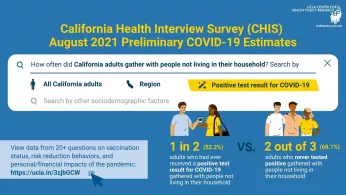Publications Menu
Authors evaluate the use of dynamic adaptive design methods to target outbound computer-assisted telephone interviewing (CATI) in the California Health Interview Survey. Authors used a difference-in-difference design to evaluate the effect of the adaptive design on calling effort, completion rates, and the demographic composition of respondents.
Authors evaluate the use of dynamic adaptive design methods to target outbound computer-assisted telephone interviewing (CATI) in the California Health Interview Survey. Authors used a difference-in-difference design to evaluate the effect of the adaptive design on calling effort, completion rates, and the demographic composition of respondents.
The COVID-19 pandemic has adversely affected Asian Americans, Native Hawaiians, and Pacific Islanders (AA and NHPIs) in many ways — through economic hardship, negative health outcomes, and rising incidents of hate and violence. This joint report with AAPI Data examines gaps in accessing health, mental health, and social services for AA and NHPI communities in California.
The COVID-19 pandemic has adversely affected Asian Americans, Native Hawaiians, and Pacific Islanders (AA and NHPIs) in many ways — through economic hardship, negative health outcomes, and rising incidents of hate and violence. This joint report with AAPI Data examines gaps in accessing health, mental health, and social services for AA and NHPI communities in California.
The COVID-19 pandemic has adversely affected Asian Americans, Native Hawaiians, and Pacific Islanders (AA and NHPIs) in many ways — through economic hardship, negative health outcomes, and rising incidents of hate and violence. This joint report with AAPI Data examines gaps in accessing health, mental health, and social services for AA and NHPI communities in California.
The COVID-19 pandemic has adversely affected Asian Americans, Native Hawaiians, and Pacific Islanders (AA and NHPIs) in many ways — through economic hardship, negative health outcomes, and rising incidents of hate and violence. This joint report with AAPI Data examines gaps in accessing health, mental health, and social services for AA and NHPI communities in California.
The California Health Interview Survey (CHIS) has employed an addressed-based sampling (ABS) frame with a mail push-to-web interview followed by a telephone nonresponse follow-up as the primary data collection approach since 2019. However, the nature of the self-administered web survey results in more survey break-offs than the previous computer-assisted telephone interview (CATI).
The California Health Interview Survey (CHIS) has employed an addressed-based sampling (ABS) frame with a mail push-to-web interview followed by a telephone nonresponse follow-up as the primary data collection approach since 2019. However, the nature of the self-administered web survey results in more survey break-offs than the previous computer-assisted telephone interview (CATI).
Health data for Asian Americans (AA) and Native Hawaiians and Pacific Islanders (NHPI) are often grouped into an "overall" category. However, when the data for each ethnicity within AA and NHPI populations are looked at individually, or disaggregated, wide variations in health are obvious. The onset of COVID-19 has amplified the importance of disaggregating AA and NHPI health data.
Health data for Asian Americans (AA) and Native Hawaiians and Pacific Islanders (NHPI) are often grouped into an "overall" category. However, when the data for each ethnicity within AA and NHPI populations are looked at individually, or disaggregated, wide variations in health are obvious. The onset of COVID-19 has amplified the importance of disaggregating AA and NHPI health data.
As a large, well-established population survey, the California Health Interview Survey (CHIS) was well-poised to adapt to the changing conditions and challenges presented by the COVID-19 pandemic. The authors’ goal was to continue to provide equity-focused data products relevant to public health, but with a more rapid data processing timeframe to meet the immediate insights needed during the pandemic. This study uses data from the 2020 CHIS.
As a large, well-established population survey, the California Health Interview Survey (CHIS) was well-poised to adapt to the changing conditions and challenges presented by the COVID-19 pandemic. The authors’ goal was to continue to provide equity-focused data products relevant to public health, but with a more rapid data processing timeframe to meet the immediate insights needed during the pandemic. This study uses data from the 2020 CHIS.
The notion of respondent contact burden in sample surveys is defined, and a multi-stage process to develop policies for curtailing nonresponse follow-up is described with the goal of reducing this burden on prospective survey respondents. The method depends on contact history paradata containing information about contact attempts both for respondents and for sampled nonrespondents.
The notion of respondent contact burden in sample surveys is defined, and a multi-stage process to develop policies for curtailing nonresponse follow-up is described with the goal of reducing this burden on prospective survey respondents. The method depends on contact history paradata containing information about contact attempts both for respondents and for sampled nonrespondents.
The notion of respondent contact burden in sample surveys is defined, and a multi-stage process to develop policies for curtailing nonresponse follow-up is described with the goal of reducing this burden on prospective survey respondents. The method depends on contact history paradata containing information about contact attempts both for respondents and for sampled nonrespondents.
The notion of respondent contact burden in sample surveys is defined, and a multi-stage process to develop policies for curtailing nonresponse follow-up is described with the goal of reducing this burden on prospective survey respondents. The method depends on contact history paradata containing information about contact attempts both for respondents and for sampled nonrespondents.

















